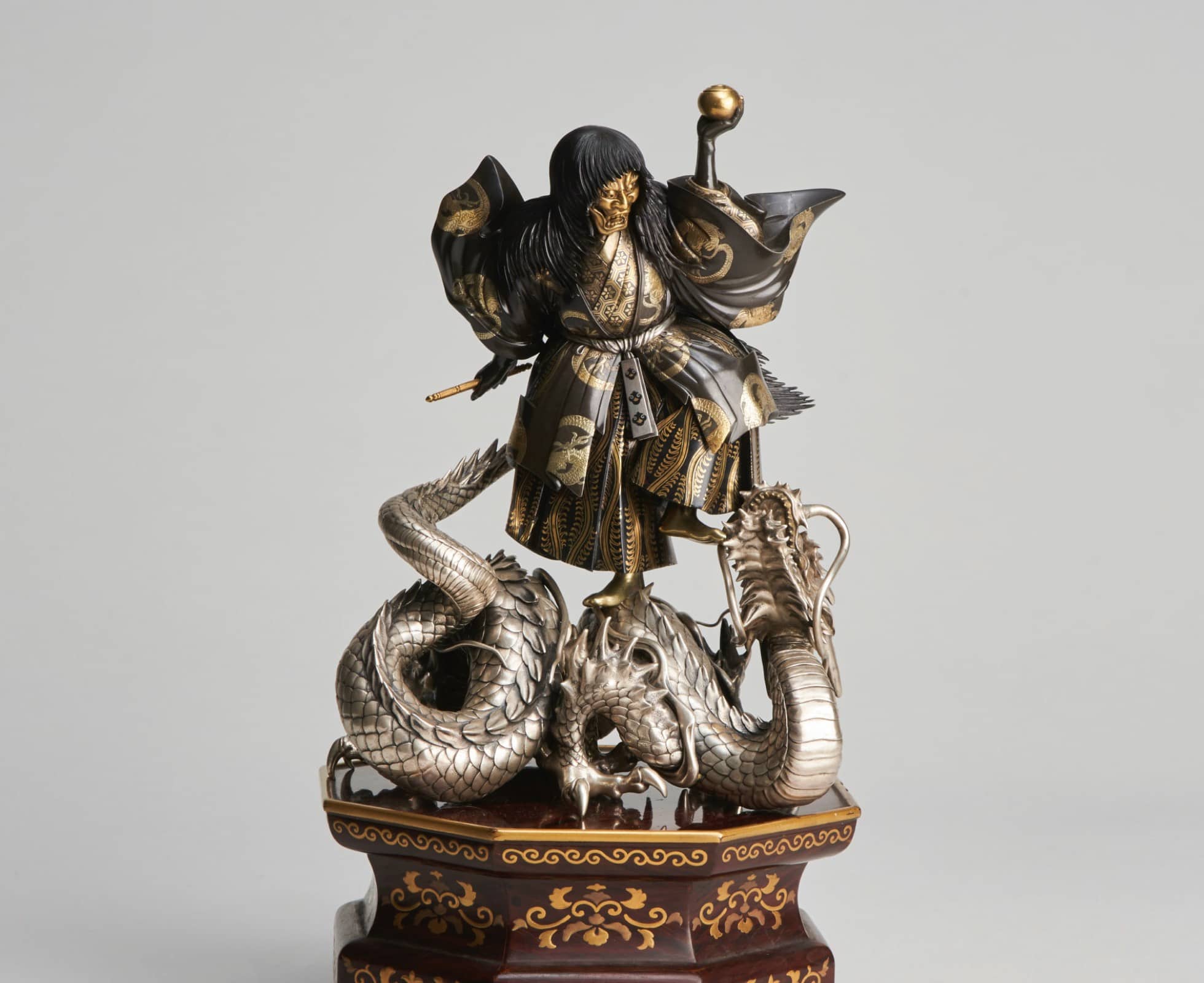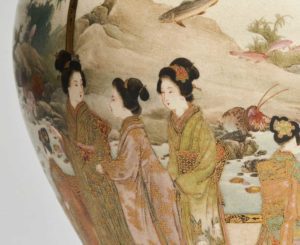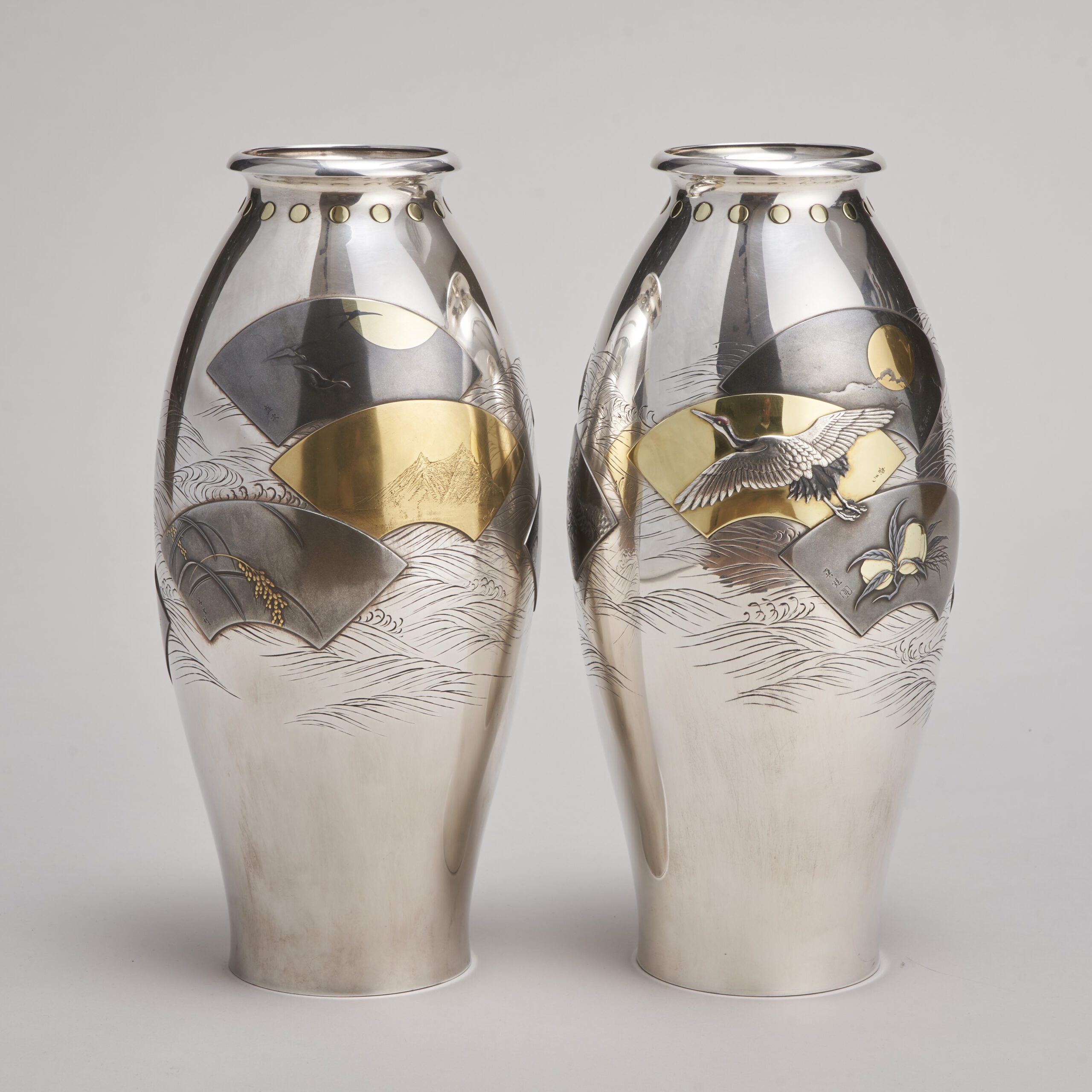Our featured item for December is this stunning pair of Japanese Silver vases with beautiful multi-metal decoration and bearing multiple artist signatures.
In this article we look at just how much craftsmanship and symbolism can be found in a single pair of vases. Each vase is decorated with numerous fan-shaped multi-metal panels. Each panel has a different subject and signature. Click on any of the images below for a closer look. We hope you enjoy the read.
The Moon:
Signed: 美鏡刻 Bikyo koku (Engraved by Bikyo) / Artist: 小林美鏡 Kobayashi Bikyo.
Although Bikyo is not recorded in the Kinko Jiten (Japanese directory of metalworkers), the second character ‘Kyo’ suggests he was a pupil of the famous artist Tsukada Shukyo (1848-1918). The moon is the subject of much mythology in Japan, it’s depiction can symbolize national well-being (From Shinto beliefs) or inner enlightenment (Buddhist beliefs)
The Peach:
Signed: 真鏡 with seal 真 “Shinkyo with seal Shin” / Attributed to:Murakami Shinkyo 村上真鏡

Although the relationship between Shinkyo and the famous metalworker Tsukada Shukyo (1848-1918) appears not to be recorded, both the refinement of his work and the second character of his name, Kyo, suggest that he was a pupil of Shukyo. Peaches are a common symbol in Japanese art representing immortality or the wish for a healthy life. They are also associated with luck, and the elimination of evil.
The Gold Crane:
Signed: 親光 Chikamitsu / Artist: Kobayashi Chikamitsu (Kobayashi Shinko) 小林親光.
Chikamitsu was active during the late Meiji/ Taisho period and into the 1940’s. He is listed in the Kinko Jiten as making flower vessels and metal fittings. In Japan the red crowned Crane is a much-revered bird. It is a symbol of strength, good fortune and longevity.
The Crane was thought to live for 1,000 years. in captivity red crowned cranes have been known to live for 75 years making it one of the longest lived birds. The red crowned crane is currently endangered due to loss if it’s wetland habitat with less than 2000 individuals in the wild, about 950 of these being in Japan.
Puppies:
Siged: 洸波刻 Koha koku (Engraved by Koha)
Unfortunately there doesn’t appear to be much information about this artist. However he is known to have worked for the Hattori company where he made a small silver box with decoration of Paulownia Flower and Phoenix. In Japan, the dog was believed to have be domesticated as early as 10,000 BC. White dogs are particularly auspicious and often appear in folk tales. The dog is one of the Zodiac animals. They represent diligence and devotion. Dogs are still revered today and there is a popular statue outside Shibuya station commemorating Hachiko the faithful dog who lived in the 1920’s. Legend has it that he met his master at the station every day until the mans death. For 10 years after that, Hachiko continued to wait at the station and became a popular symbol of devotion.
Wheat:
Signed: Biko (Yoshiyuki) 美幸 / 帖佐美幸 Attributed to Chosa Biko
Before the second Sino-Japanese war (1937-1945) wheat was not so common in the Japanese diet with rice being the staple carbohydrate. In the 1900’s, western-influenced pastries, cakes and sweet buns called “Anpan” were popular and fashionable with the middle classes. Wheat was seen as an exclusive treat not an essential food source. After the second world war there were rice shortages and much of the aid from foreign countries was wheat based an so it became a more common food source.
Mount Fuji:
Signed: Katsunobu 勝信 with a Kao / Ishikawa Katsunobu (1869-1949) 石川勝信
Mount Fuji is a stratovolcanic mountain. It is 3,775 metres tall and the 35th tallest mountain in the world. It is praised for it’s attractive symmetry which has made it the subject of many poems and works of art. It is an important symbol of Japan and has huge significance in the Shinto religion. There are many shrines at the base and on the ascent of Fuji – they honour Princess Konohanasakuya the Kami (Deity) whose symbol is cherry blossom.
The Chrysanthemum:
大津年信 Otsu Toshinobu / Signed: Toshinobu koku年信刻 / Art name: Kiseisai煇星斎
The artist was a younger brother of Otsu Yoshin 1899―1979 and worked for the Hattori Company. The Chrysanthemum represents longevity, nobility and rejuvenation. It is a symbol of Autumn (Fall) and the motif is used to represent the imperial family and Japan itself.
The Peony:
介川芳秀 Sukegawa Hoshu (1898-1975) / Signed: Hoshu saku芳秀作
Sugawa Hoshu was born in Mito City, Ibaragi Prefecture. He regularly won prizes, including a bronze prize at the Nihon Bijutsu Kyokai Tai [Japan Art Exhibition] .In 1931, he exhibited at the Government sponsored Teiten exhibition and won prizes at the Bunten exhibitions. In 1932, he graduated from the sculpture department of the Tokyo University of Fine Art. And in 1950, he was appointed a President at the Nihon Dento Kogei Kai (Japan Art Crafts Association.) His work can be found in the Ibaragi Prefecture Museum of Modern Art. Known as the King of Flowers in Japan, The Peony signifies good fortune, bravery and honour.
Trout:
小林華光 Kobayashi Kako (1880-1955) / Signed: Kako sen華光鐫 小林華光 (1880-1955)
The work of Kako can be found in the Japanese Imperial Collection at the Sannomaru Shozokan Museum, Tokyo. In the culture of the Ainu people of Northern Japan, the Trout is a much-revered animal and it is believed that it carries the world upon it’s back. When it shakes it’s back it causes earthquakes and when it shoots water out of its mouth it causes Tsunami.
Peaches:
Signed: 真鏡 with seal 真 “Shinkyo with seal Shin” Attributed to Murakami Shinkyo 村上真鏡
Although the relationship between Shinkyo and the famous metal-worker Tsukada Shukyo (1848-1918) appears not to be recorded, both the refinement of his work and the second character of his name, Kyo, suggest that he was a pupil of Shukyo. Peaches are a common symbol in Japanese art, representing immortality or the wish for a healthy life. They are also associated with luck, and the elimination of evil.
Birds and the Moon:
高川盛次 Takagawa Moritsugu Meiji- Taisho periods Signed: Moritsugu 盛次
Takagawa Moritsugu was a pupil of Unno Yoshimori (1864-1919). The Moon is the subject of much mythology in Japan. Its depiction can symbolize national well-being (From Shinto beliefs) or inner enlightenment (Buddhist beliefs)
The Gold Mountain:
海野清 Unno Kiyoshi / Signed: 清作Kiyoshi Saku (Made by Kiyoshi)
Artist: Unno Kiyoshi (1884 -1956), who was designated a Living National Treasure (Ningen Kokuho) artist in 1955
One of the most enduring and ancient belief in Japan is that the Gods inhabit the mountains. Japan is a Mountainous landscape and climbing them is not just recreational, it is also an act of pilgrimage.
The Rabbit:
Signed: Mitsuyoshi 光美 with a seal 祥 Sho
Across Asia, the Rabbit is known to be the luckiest of the twelve animals of the zodiac. It symbolises beauty, mercy and elegance. You can read our article about the Year of the Rabbit by clicking here.
The Pine Tree:
Signed: 春芳 Shunpo/ Haruyoshi / Seal: 五郎 Goro.
Artist: 高島春芳Takashima Shunpo/ Takashima Shunho. Dies 1970
In Japan, Pine trees represent longevity, good fortune and steadfastness. They are a symbol of the Japanese New Year bringing rebirth and a bright future.
and finally, here you can enjoy the vases in all their glory….
We hope you found this blog interesting. For more articles inspired by our collection of Chinese and Japanese Fine Art and Antiques, click here.



















